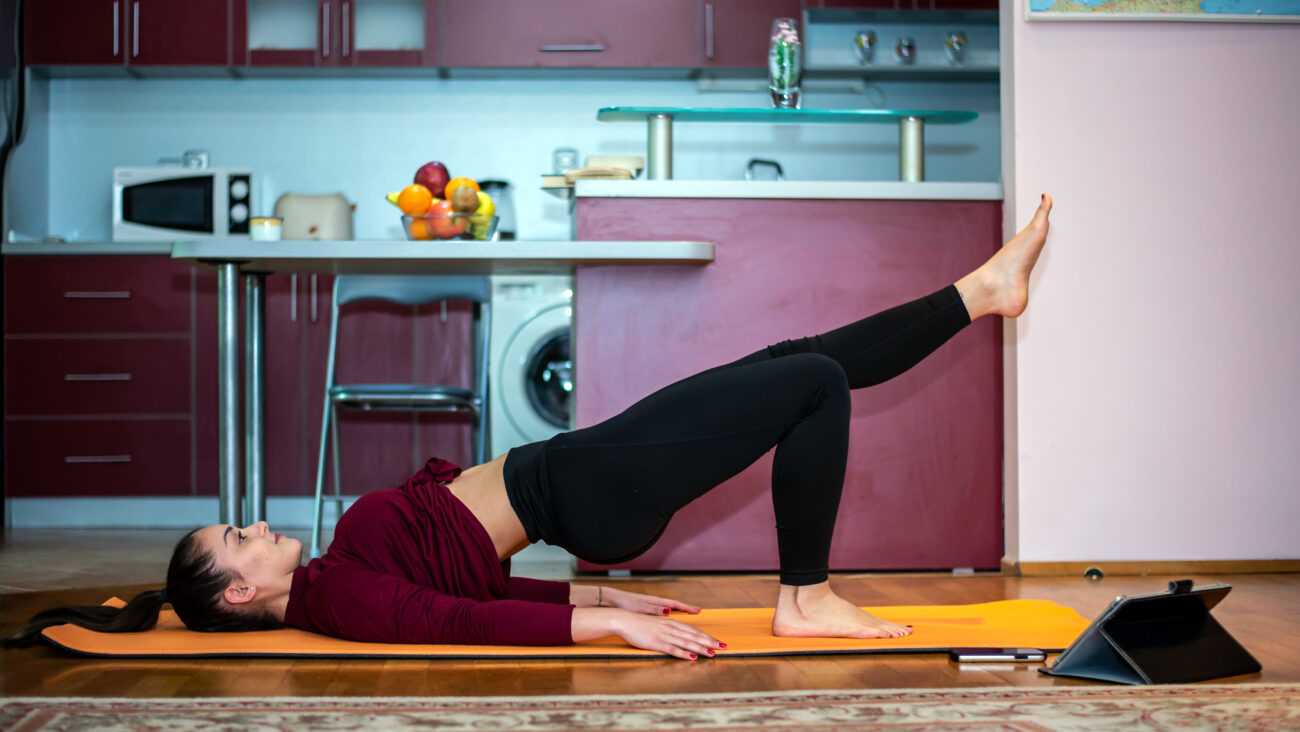Blog
10 Best Bodyweight Leg Exercises For Toned Legs (No Equipment Needed!)

While lower-body strength training seems synonymous with lifting weights, you don’t always need dumbbells, kettlebells, barbells — or any equipment, for that matter — to get a solid workout. In fact, you can build strength simply by performing bodyweight leg exercises.
The best part? Skipping the equipment means you can do bodyweight leg exercises anywhere and anytime. “A lot of us see time, money, and space as an obstacle to getting in a workout,” says Tara Nicolas, NASM-CPT, an instructor at The Fhitting Room in New York City. “But bodyweight training is cheap, and you really don’t need much room.”
Benefits of Bodyweight Exercises
Bodyweight exercises have several benefits beyond just being a no-equipment-needed, convenient workout. For starters, you have better control of your lower-body movements without having a weight to hoist around. Ditching a weighted counterbalance during stability exercises means you can really focus on how your body moves and what you need to do to keep it steady. “Bodyweight exercises help you get in touch with how your body is moving and any imbalances you may have on one side,” says Nicolas.
With these bodyweight leg exercises, in particular, you can also sidestep injury by strengthening typically weaker muscle groups, like the hamstrings and glutes. For those who don’t love doing regular cardio, such as running or cycling, a study in the International Journal of Exercise Science found that bodyweight exercises also improve cardiovascular fitness. To get this benefit, make sure you don’t rest too long between sets and exercises to keep your heart rate up.
Bodyweight exercises can also build muscle mass. However, keep in mind that once you reach a certain point and your body adapts, you must add resistance or weights to progress. Lastly, bodyweight exercises are also functional movements that engage multiple muscle groups. This means they strengthen the muscles that replicate activities in your daily life.
Best Tips for Training Leg Muscles
Getting strong, toned legs requires a consistent exercise program. To avoid injury and to maximize your workout, follow these tips for training your leg muscles:
- Get your muscles primed for movement with a 5 to 10-minute warm-up routine, consisting of activities like walking, running in place, jumping jacks, and arm circles.
- Do foam rolling before or after exercises to increase blood flow to your muscles.
- After your workout, cool down with full-body stretches to improve your overall flexibility.
- To increase the intensity of bodyweight exercises and challenge yourself, increase the number of repetitions or sets you perform. You can also reduce the rest time between sets or exercises.
- Incorporate some plyometric moves, such as jump squats or lunge jumps, to increase strength, power, and endurance.
- Watch for signs of overtraining, such as chronic muscle soreness, muscle strains, or joint pain. Make sure you work in rest days into your weekly routine.
Ready to reap all the rewards bodyweight exercises have to offer? Combine these must-do moves from Nicolas into a bodyweight leg workout that’s sure to leave your lower body shaking after just one round.
Equipment-Free Bodyweight Leg Workout
How it works: To warm up, foam roll the quads, glutes, calves, and back, then do 20 seconds each of air squats, lateral lunges, and inchworms. Then, do each exercise in the bodyweight leg workout for the suggested time. Perform as many rounds of the circuit as you desire.
What you’ll need: no equipment required
3 x 6 x 1 Squat
A. Stand with feet slightly wider than hip-width apart, toes turned slightly outward and hands at sides.
B. On an inhale, sit back into hips and bend knees to lower until thighs are parallel or almost parallel with floor, moving on a count of three. Keep chest up and prevent back from rounding throughout movement.
C. Hold the bottom of the squat for a count of six. Then, on an exhale, press through feet to straighten legs and return to standing on a count of one.
Continue for 45 seconds.
Modification: If you can’t squat down that low, only go down as far as you can comfortably go. As your strength and flexibility improve (as this move requires both), you will be able to squat down further. You can also perform this squat with your back against the wall to give you some stability until you can do this move without support.
Progression: If this move feels too easy, turn this into a jump squat by extending your legs and jumping up out of the squat.
Squat with Alternating Calf Raise
A. Stand with feet hip-width apart. On an inhale, sit back into hips and bend knees to lower into a squat.
B. Holding the squat position and keeping core engaged, lift left heel to perform calf raise. Lower left heel back to the floor, then repeat the movement on right side.
Continue alternating for 45 seconds.
Modification: If you have difficulty maintaining good form while lifting both heels in a sustained squat, lift one heel with each squat. Make sure you are alternating heel lifts with each squat.
Progression: To make this move more difficult, lift both heels at the same time while in the squat position.
Quadrupled Hip Extension
A. Start in a table-top position on the floor with hands stacked directly under shoulders, knees bent and stacked directly under hips, and feet hip-width apart. Lift right knee and foot slightly off the floor to start.
B. Pull right heel in toward butt and drive heel up toward the ceiling, making sure to engage core and keep a neutral spine.
C. Lower right knee back down toward the floor without touching it.
Continue for 45 seconds. Switch sides; repeat.
Modification: If you have difficulty getting into this position on the floor or it irritates your knees, you can perform this same move standing up and holding onto a stable surface for balance.
Progression: To make this exercise more difficult, perform five pulses up between each full movement.
Quadrupled Hamstring Curl
A. Start in a table-top position on the floor with hands stacked directly under shoulders, knees bent and stacked directly under hips, and feet hip-width apart. Extend right leg straight back and lift it to hip height to start.
B. Holding right leg in line with hip, bend right knee to curl heel in toward right glute.
C. Straighten right leg back to the starting position, keeping leg at hip height.
Continue for 45 seconds. Switch sides; repeat.
Modification: If you have difficulty maintaining your balance with this move, keep your leg straight and pulse it up. As your balance and strength improve, you can progress to bending your leg.
Progression: Use an ankle weight for added resistance to increase strength.
Quadrupled Fire Hydrant
A. Start in a table-top position on the floor with hands stacked directly under shoulders, knees bent and stacked directly under hips, and feet hip-width apart.
B. Keeping right knee bent, lift right leg up and out to the side, raising it to hip height. Then, lower it back down to the starting position.
Continue for 45 seconds. Switch sides; repeat.
Modification: To make this move less challenging, rest on your forearms instead of your hands for more support. You can also limit how far you lift your leg to the side until your strength improves.
Progression: Use an ankle weight or a resistance band above your knees to make this move more challenging.
Lateral Lunge Balance
A. Stand with feet together, hands clasped in front of chest.
B. Step out to the right side with right foot, knees and toes pointing forward. Bend through right knee and press hips back, keeping weight in right heel and right knee over ankle.
C. Press through right foot to return to standing, then drive right knee toward chest while balancing on left leg.
Continue for 45 seconds. Switch sides; repeat.
Modification: If you feel unsteady and need more support, stand near a chair to balance yourself as needed. You can also place your foot down before lifting it back up for additional support.
Progression: To make this more difficult, increase the speed or alternate legs to challenge your balance.
Squat Jump
A. Stand with feet slightly wider than hip-width apart, toes turned slightly outward and hands at sides.
B. On an inhale, sit back into hips and bend knees to lower until thighs are parallel or almost parallel with floor. Keep chest up and prevent back from rounding throughout movement.
C. On an exhale, explosively jump up, straightening legs. Land softly with bent knees, lowering back down into a squat.
Continue for 30 seconds.
Modification: If you struggle with this move, try reducing how high you jump or perform a jump every other squat.
Progression: To make this more difficult, increase how high you jump. You can also turn this into a tuck jump by lifting your knees as you jump.
Speed Skater
A. Stand with feet hip-width apart and arms at sides. Shift weight into left foot, then press through left foot and jump out to the right, landing softly on right leg with left foot swinging behind. Arms can swing naturally.
B. Quickly push off right foot to jump to the left, landing softly on left leg with right foot swinging behind left leg.
Continue alternating for 30 seconds.
Modification: If this move is too challenging, hold onto a stable surface for added stability. You can also step into this move instead of jumping side to side.
Progression: To challenge yourself, increase the distance you jump to each side, or pick up the speed.
Single-Leg RDL
A. Stand with feet hip-width apart and arms at sides. Shift weight into right leg, maintaining a slight bend in knee, and lift left leg off the floor, knee bent at a 45-degree angle.
B. Hinge at hips and lean forward with chest while lifting left leg behind, body moving in one straight line. Keep the left leg straight and shoulders down and back. Stop lowering chest once torso and leg are parallel to the floor.
C. Raise arms straight out to sides in an airplane position to help balance. Then, push through right foot and lower left leg and arms to return to start.
Continue for 45 seconds. Switch sides; repeat.
Modification: Keep your knee bent (instead of straightening it) while hinging at the waist to make this move less challenging. You can also keep your arms straight down instead of raising them out to the side.
Progression: To make this more challenging, pulse your leg up several times when in the outstretched position. You can also increase the speed with which you perform this move to challenge your balance.
Side-Lying Leg Lift
A. Lie on left side of body on the floor with legs extended and let hand propping head up, elbow resting on the floor. Draw right knee in toward chest and rest it on the floor in front of hip.
B. With the left foot flexed, lift it two to three inches up toward the ceiling. Pause at the top, then lower foot back to the starting position.
Continue for 45 seconds. Then, hold left leg at the top and pulse for 45 seconds. Switch sides; repeat.
Modification: Try placing a pillow under your bent leg or your straight leg for stability and to reduce the range of motion needed to lift your leg.
Progression: To make this move more challenging, pulse your leg several times between sets. You can also place a resistance band above your knees.












